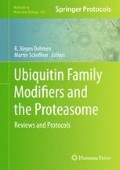Abstract
The biological role and fates of ubiquitin (Ub) conjugates are determined by the nature of the ubiquitin chain formed on the protein. Recently, we reported that Ring-finger and U-box ubiquitin ligases (E3s), when functioning with different E2s, synthesize different types of ubiquitin chains on the same substrate, and with UbcH5, form a novel type of chain that is resistant to degradation and deubiquitination by 26S proteasomes. Analysis by mass spectrometry demonstrated that these chains are forked; i.e., two Ub moieties are linked to neighboring lysines on the proximal Ub. In an effort to find the cellular mechanisms that protect against the generation of such nondegradable Ub conjugates, we discovered that the presence of S5a (Rpn10) or a GST-fusion of S5a’s UIM domains in a ubiquitination reaction led to the formation of conjugates that were rapidly degraded. Mass spectrometry revealed that S5a and GST-UIM prevent the formation of Ub forks without affecting the synthesis of standard isopeptide linkages. S5a is an abundant Ub-binding UIM protein present in the 26S proteasome and free in the cell. Preventing forked chain formation appears to be one role of free S5a. The forked Ub chains bind poorly to 26S proteasomes, unlike homogeneous Ub chains containing K63 or K48 linkages and chains synthesized with S5a present. Thus, S5a (and presumably some other cellular UIM-proteins) functions like a molecular chaperone with certain E2–E3 pairs to ensure synthesis of efficiently degraded nonforked ubiquitin conjugates.
Access this chapter
Tax calculation will be finalised at checkout
Purchases are for personal use only
References
Chau V, Tobias JW, Bachmair A et al (1989) A multiubiquitin chain is confined to specific lysine in a targeted short-lived protein. Science 243:1576–1583.
Gregori L, Poosch MS, Cousins G, Chau V (1990) A uniform isopeptide-linked multiubiquitin chain is sufficient to target substrate for degradation in ubiquitin-mediated proteolysis. J Biol Chem 265:8354–8357.
Wu-Baer F, Lagrazon K, Yuan W, Baer R (2003) The BRCA1/BARD1 heterodimer assembles polyubiquitin chains through an unconventional linkage involving lysine residue K6 of ubiquitin. J Biol Chem 278:34743–34746.
Goldberg AL (2003) Protein degradation and protection against misfolded or damaged proteins. Nature 426:895–899.
Hershko A, Ciechanover A (1998) The ubiquitin system. Annu Rev Biochem 67:425–479.
Pickart CM, Cohen RE (2004) Proteasomes and their kin: proteases in the machine age. Nat Rev Mol Cell Biol 5:177–187.
Johnson ES, Ma PC, Ota IM, Varshavsky A (1995) A proteolytic pathway that recognizes ubiquitin as a degradation signal. J Biol Chem 270:17442–17456.
Deng L, Wang C, Spencer E et al (2000) Activation of the IkappaB kinase complex by TRAF6 requires a dimeric ubiquitin-conjugating enzyme complex and a unique polyubiquitin chain. Cell 103:351–361.
Hicke L, Dunn R (2003) Regulation of membrane protein transport by ubiquitin and ubiquitin-binding proteins. Annu Rev Cell Dev Biol 19:141–172.
Spence J, Sadis S, Haas AL, Finley D (1995) A ubiquitin mutant with specific defects in DNA repair and multiubiquitination. Mol Cell Biol 15:1265–1273.
Barriere H, Nemes C, Du K, Lukacs GL (2007) Plasticity of polyubiquitin recognition as lysosomal targeting signals by the endosomal sorting machinery. Mol Biol Cell 18:3952–3965.
Hoege C, Pfander B, Moldovan GL et al (2002) RAD6-dependent DNA repair is linked to modification of PCNA by ubiquitin and SUMO. Nature 419:135–141.
Lipford JR, Smith GT, Chi Y, Deshaies RJ (2005) A putative stimulatory role for activator turnover in gene expression. Nature 438:113–116.
Kim HT, Kim KP, Lledias F et al (2007) Certain Pairs of Ubiquitin-conjugating Enzymes (E2s) and Ubiquitin-Protein Ligases (E3s) Synthesize Nondegradable Forked Ubiquitin Chains Containing All Possible Isopeptide Linkages. J Biol Chem 282:17375–17386.
Peng J, Schwartz D, Elias JE et al (2003) A proteomics approach to understanding protein ubiquitination. Nat Biotechnol 21:921–926.
Peth A, Uchiki T, Goldberg AL (2010) ATP-dependent steps in the binding of ubiquitin conjugates to the 26S proteasome that commit to degradation. Mol Cell 40:671–681.
Kim HT, Kim KP, Uchiki T et al (2009) S5a promotes protein degradation by blocking synthesis of nondegradable forked ubiquitin chains. Embo J 28:1867–1877.
Uchiki T, Kim HT, Zhai B et al (2009) The Ubiquitin-interacting Motif Protein, S5a, Is Ubiquitinated by All Types of Ubiquitin Ligases by a Mechanism Different from Typical Substrate Recognition. J Biol Chem 284:12622–12632.
Deveraux Q, Ustrell V, Pickart C, Rechsteiner M (1994) A 26 S protease subunit that binds ubiquitin conjugates. J Biol Chem 269:7059–7061.
van Nocker S, Deveraux Q, Rechsteiner M, Vierstra RD (1996) Arabidopsis MBP1 gene encodes a conserved ubiquitin recognition component of the 26S proteasome. Proc Natl Acad Sci U S A 93:856–860.
van Nocker S, Sadis S, Rubin DM et al (1996) The multiubiquitin-chain-binding protein Mcb1 is a component of the 26S proteasome in Saccharomyces cerevisiae and plays a nonessential, substrate-specific role in protein turnover. Mol Cell Biol 16:6020–6028.
Hofmann K, Falquet L (2001) A ubiquitin-interacting motif conserved in components of the proteasomal and lysosomal protein degradation systems. Trends Biochem Sci 26:347–350.
Wang Q, Young P, Walters KJ (2005) Structure of s5a bound to monoubiquitin provides a model for polyubiquitin recognition. J Mol Biol 348:727–739.
David Y, Ziv T, Admon A, Navon A (2010) The E2 ubiquitin-conjugating enzymes direct polyubiquitination to preferred lysines. J Biol Chem 285:8595–8604.
Windheim M, Peggie M, Cohen P (2008) Two different classes of E2 ubiquitin-conjugating enzymes are required for the mono-ubiquitination of proteins and elongation by polyubiquitin chains with a specific topology. Biochem J 409:723–729.
Acknowledgments
These studies were supported by a grant from the National Institute of Health (NIGMS 5R01 GM51923) and a Senior Fellowship to ALG from the Ellison Foundation.
Author information
Authors and Affiliations
Corresponding author
Editor information
Editors and Affiliations
Rights and permissions
Copyright information
© 2012 Springer Science+Business Media, LLC
About this protocol
Cite this protocol
Kim, H.T., Goldberg, A.L. (2012). Formation of Nondegradable Forked Ubiquitin Conjugates by Ring-Finger Ligases and Its Prevention by S5a. In: Dohmen, R., Scheffner, M. (eds) Ubiquitin Family Modifiers and the Proteasome. Methods in Molecular Biology, vol 832. Humana Press. https://doi.org/10.1007/978-1-61779-474-2_45
Download citation
DOI: https://doi.org/10.1007/978-1-61779-474-2_45
Published:
Publisher Name: Humana Press
Print ISBN: 978-1-61779-473-5
Online ISBN: 978-1-61779-474-2
eBook Packages: Springer Protocols

